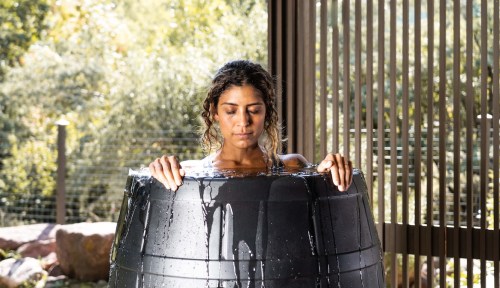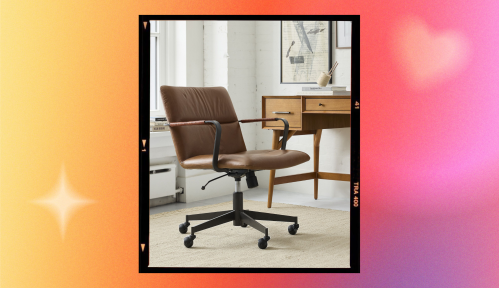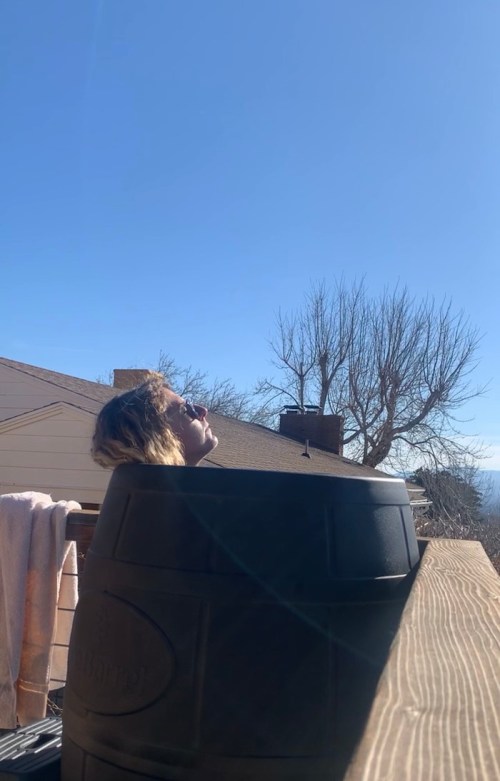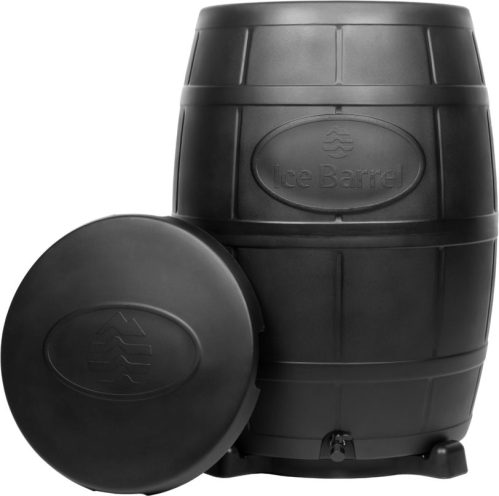Our editors independently select these products. Making a purchase through our links may earn Well+Good a commission
I Took an Ice Bath Every Day for 2 Weeks—Here’s How It Soothed My Aches and Pains
Just three minutes a day for two weeks made a world of difference to my chronic aches and pains. Read my full review here.

It’s not every day—or ever—that I take an ice bath. I’m like a lizard in which I perpetually run cold and can frequently be found sprawling in the sun and/or looking for warm places to rest in. If I am subjected to the cold, it’s bundled up underneath layers (my portable heat lamp) to make sure I don’t freeze. But I rarely voluntarily look to put myself in freezing situations.
Experts in This Article
certified Wim Hof instructor and guide with Flash Pack
certified athletic trainer and strength and conditioning specialist
However, I am a hurt lizard. I recently tore my ACL and MCL on ski trip and have struggled with inflammation and muscle soreness since January. Layer on chronic back pain and achey-ness, and I’m always looking for different ways to remedy my own discomfort.
8 Stylish and Adjustable Office Chairs a Chiropractor Would Approve Of

ThirdLove Just Launched Bras That Help Balance Your Body Temperature—Here’s Why That’s a Game-Changer for Women in All Life Stages

These Are the Summer Essentials You Should Bring With You Every Time You Leave the House, According to a Derm and an RD

So when I was offered the opportunity to test the Ice Barrel Cold Plunge Tub ($1,200), an at-home cold therapy training tool, I couldn’t resist testing it out. Did it sound absolutely torturous? Yes, 100 percent. But could it help soothe my aches and pains? I wanted to find out.
Ice Barrel, Cold Plunge Tub — $1,200.00
The easiest way to start your own cold exposure therapy routine. All you have to do is fill ‘er up and chill out.
Ice is hot—here’s why
While cold baths are the hot “new” trend, they’re not exactly new. A quick Google search will show you that thermal medicine and therapeutic baths (both hot and cold) have been around since the days of the Ancient Greeks, who relied on water to treat everything from muscle soreness to skin disease.
What’s become mainstream recently is the Wim Hof Method. Dubbed “The Iceman” for his unique ability to polar plunge for long amounts of time, Wim Hof is a Dutch extreme athlete who has combined breath work, cold exposure therapy, and mental toughness to create the Wim Hof Method, which has been linked to various health and wellness benefits.
Andri Einarrson, a certified Wim Hof instructor, leads the cold water therapy experience on adventure travel company Flash Pack’sUnknown Iceland trip. He explains that cold exposure therapy ultimately comes down to being in control of your stress response, which helps your body and brain in different ways.
“There are many mental and physical benefits of cold exposure” Einarsson explains. “For example, cold reduces inflammation, swelling, and sore muscles. It is also linked to improved quality of sleep, more focus, and even to an improved immune response. Participants have reported health benefits that range from higher energy levels to relief of symptoms caused by autoimmune diseases.”
Another Google search confirms Einarsson’s statements—many people swear by cold exposure therapy in their recovery routines. Scroll through blog after blog praising the icy therapy for its magical ability to treat everything from physical ailments like torn ACLs like my own, to more nuanced issues like anxiety and depression. (Although for any chronic pain or mental health issues, it’s always best to talk to your doctor or healthcare provider to get their input.)
Kari Lansing, MS, CTSC, an athletic trainer and strength conditioning coach in Lake Placid, NY, explains that other proposed benefits include an increased circulation to your core and vital organs (since you’re decreasing the blood flow to extremities), temporary and minor increase in metabolic rate, and increased immunity. But cold therapy—be it in an Ice Barrel or a regular bathtub—isn’t foolproof.
“Despite there being an abundance of research on the topic, the primary mechanisms for its ability to improve recovery and health are still not fully understood,” she says. “A lot more research is needed to connect the subjective, ‘I just feel better’ reactions to the objective laboratory results explaining why people feel better.”
Ice Barrel review: An easy way to “chill” out
The jury was out on ice bathing, and I needed to find out for myself, and thus, ordered my very own cold plunge tub. While I waited for my insulated pickle barrel to arrive, I asked for tips on how ice bath beginners could prep for their experiences. Both Einarrson and Lansing recommended easing yourself into ice baths using cold showers and ice-free baths.
“Gradual cold exposure and listening to the body, never forcing, is the way to build cold tolerance until you are ready to try an ice bath,” Einarsson said. “What you can do is put cold water (no ice) in your barrel and see if you manage to be as relaxed as if it was hot water. If not, keep with cold showers until you manage to go into the barrel in total relaxation.”
Breath work is also key, as long inhales and steady exhales help connect the body and mind to aid in stress relief. And, of course, consistency. “Progressively make the water a little colder each day. This will help you to adjust and tolerate the colder temperatures and basically make you hate it less, allowing yourself a better chance of sticking to it,” Lansing suggested. “Be consistent by doing it every day in order to build the tolerance to colder temperatures faster.
A few weeks (and cold showers) later, and a ginormous cardboard box arrive on my doorstep.
My first observation was how simple the tub was to set up. Be forewarned that it comes in a big, intimidating box, so you think it’s going to take a while to set up, but it’s quite the opposite. It comes in four simple pieces: the barrel itself, a stand, a step stool, and a lid. Everything is made from the same lightweight plastic, so if you’re alone like I was, it’s easy to pick up and move around. All in all, setup took a breezy five minutes.
The filling is a different story—it’s a standard 55 gallon drum that holds up to 105 gallons of water, so getting it bath-ready did take a minute. Tip: make sure you have your barrel exactly where you want it to be when you fill it. Once it’s full, it’s not moving until you drain it.
Once I filled it a little over halfway with water, I realized I was missing a key component: ice. Now, you don’t need ice. But I had been prepping and wanted the full experience. Luckily, my deck was covered in snow, so I cut the hose and started shoveling heaps of snow into the barrel and stirred it into a nice, cold slurry. Once it was filled a bit higher, I grabbed my beach towel and climbed in. (You can also make ice from your freezer, or buy ice from the store.)
Full transparency: The first time I got in this thing I almost threw up. No amounts of cold showers can prepare for you climbing and submerging yourself in 30 degree water, it’s so jarring. I stood knee deep shivering for a few seconds (with my boyfriend filming and laughing at me the whole time, mind you) until I slowly lowered the rest of my body into the icy cold. It was… miserable. I think I lasted 45 seconds? That’s what the footage says at least, because I’m pretty sure I blacked out from the plunge.
Looking back, the snow was probably too much for me. “Benefits begin when the water temperature is 50 to 60 degree Fahrenheit… The recommended time in cold water is 11-15 minutes.” Lansing said. I could have warmed it up a bit, but 11-15 minutes?! I could barely stand 30 seconds. I decided my goal for the two week span was a reasonable five minutes. Turns out, it was easier than expected to achieve. Here’s my log of the first week:
- Day 2: Almost the same results as Day 1. Lasted around the same time. Sigh.
- Day 3: Forced myself to stay in for a 1.5 minutes. My arms hurt—like that dull, freeze-y pain you get when you’re super cold. It burns my skin? But got out and noticed my joints felt looser.
- Day 4: Did another 1.5 minutes. Bones still achy in the tub, but feel really nice out of the tub.
- Day 5: Made it to 2.5 minutes! Added in some breath work and swapped my tiny shorts for wool base layers. Made my skin hurt less and helped distract me a lot from the fact that I felt an ice cube.
- Day 6: Four minutes. Noticed that the “freeze-y pain” tends to go away after around the 2 minute mark, especially if you’re wearing base layers. Once you make it past that it’s actually kinda peaceful?
- Day 7: Five minutes, baby. We’re Wim Hof-ing!

Einarsson and Lansing were right—breath work is half the battle. Concentrating on a deep, steady breathing pattern helps distract you from the cold. It’s kind of like yoga or meditation where that extreme focus draws the attention away from sensory stimulation (in this case, freezing.) Once I was able to get “in the zone,” it almost felt—dare I say it—relaxing.
Can confirm—your body will, or may, love an Ice Barrel (or at least, mine did)
The second week was much different than the first week, and while I never ventured into the 11-15 minute range, I understand how other people do. Ice bathing *can* be relaxing (when you train up to 30 degree water, of course.) And I did feel better, at least physically. While I didn’t notice a difference in my anxiety or depression levels, my muscles felt great. My knees particularly felt looser and less angry than they had all winter, particularly on the days when I lasted three minutes or more.
After testing the Ice Barrel for two weeks, I think it’s an awesome tool for anyone trying to get into cold exposure therapy. The hefty price tag aside, it’s incredibly convenient. And once it’s set up, it’s set up—the insulated (and recycled plastic!) barrel and lid combo keeps water cool and clean from debris, so you can climb in whenever you want. When it gets a bit funky (usually about four weeks after the initial fill) simply unplug the drain and dry it out to refill with clean water.
One downside is its size: It’s large and takes up a decent amount of space. Luckily, I had a deck where I could pop it up and drain it, no problem. But if you live in a small space or an apartment, it might not make sense for your lifestyle. If you do have room, though, and are an athlete or recovering from an injury, it can be worth the money. That $1,200 goes a looong way in terms of simplicity and convenience. Just note your fitness (and recovery) goals before you buy:
“For those trying to build muscle mass or strength, using cold water immersion seems to reduce the benefits of strength training when using it following a strength training session,” Lansing says. “However, in endurance based athletes, such as cyclists and runners, it seems to reduce the perception of delayed onset muscle soreness when compared to either no intervention or rest alone.” And, ya know, maybe don’t fill it with snow the first time you get in.
Want to be the first to hear about the latest (and greatest) SHOP product drops, custom collections, discounts, and more? Sign up to have the intel delivered straight to your inbox.





